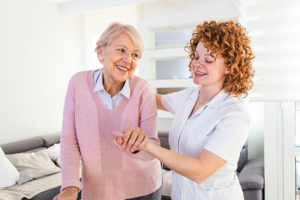Fall Safety Tips for Seniors to Regain Confidence and Strength After a Fall

Try these fall safety tips for seniors to improve safety, confidence, and independence.
While circus clowns and comedians may stir audiences to laughter over such stunts as slipping on a banana peel, there is nothing funny about falling when it comes to aging parents, who are at an elevated risk for serious injuries, which could lead to an extended rehabilitation process. Not only that, but there’s a lesser known complication that typically arises from an older adult’s fall: a fear of falling again which can be significant enough to impact quality of life and health.
As the saying goes, “Once bitten, twice shy.” It’s natural – and sensible – for an older adult who has fallen to want to take precautions to prevent a subsequent fall. Yet for most, the fear of falling prevents essential physical exercise, bringing about weakness and reduced balance confidence, each of which can actually boost the likelihood of falling again.
Instead, it’s essential for senior loved ones to:
- Strengthen muscles. Ask the doctor and/or physical therapist for appropriate exercises to engage in after a fall. Building strength is an essential component to preventing future falls.
- Assess the home. Walk through the older adult’s home to check for any cords, clutter, throw rugs, etc. which can cause a tripping hazard. Make sure there is sufficient lighting and install grab bars in the bathroom and anywhere else supplementary support might be helpful.
- Discuss it. Seniors may feel embarrassed for having fallen; however, it’s important to talk about what happened in order to decide what precautionary measures can be taken to make sure that it doesn’t occur again.
It’s also helpful for older adults to create goals, with the aid of a medical professional, and to start to work towards attaining them. The goals must be reasonable and fairly easily attainable in order to instill confidence, for example being able to walk up and down the stairs independently while holding the handrail over the next two weeks, or walking the total length of the backyard within 4 weeks.
Once an objective has been set, define the steps necessary to attain that goal. What types of training can help strengthen the muscles essential to go up and down the stairs, or to take an extended walk? And if the goal is not achieved, consider what prevented the accomplishment, and what additional steps could be taken to set and reach a brand new goal.
Most importantly, be sure to provide reassurance and support to cheer a senior on towards regaining his or her self-assurance and confidence and to lessen any fear.
For more fall safety tips for seniors, or to arrange for a no cost in-home safety assessment, call our experts in home health care in Plantation and the surrounding areas at Responsive Home Care any time at 954-486-6440.
